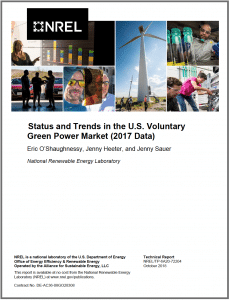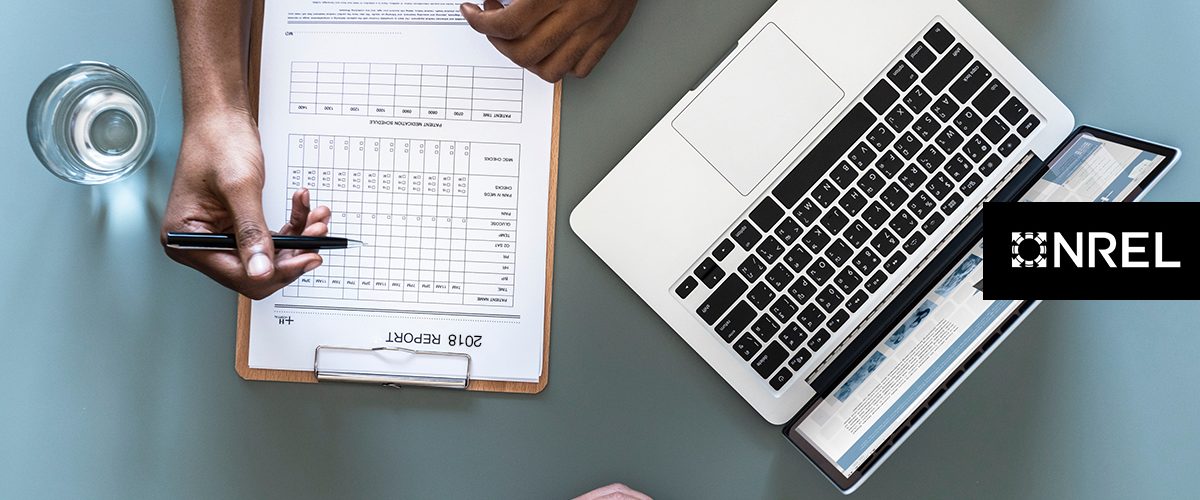 With the release of NREL’s 2017 U.S. Voluntary Green Power Market report, and most of 2018 in the rear view mirror, we can now safely look back on a few of the prevailing trends in the market with confidence and clarity as we gear up for 2019. The year of 2017 was a bumper year for the U.S. voluntary green power market: MWh sales grew almost 28% from 2016 levels – the largest YoY growth since before 2010 1 – and total sales eclipsed the 100 million MWh mark for the first time on record. Here are a few key takeaways to help explain this marked growth and keep an eye on going forward.
With the release of NREL’s 2017 U.S. Voluntary Green Power Market report, and most of 2018 in the rear view mirror, we can now safely look back on a few of the prevailing trends in the market with confidence and clarity as we gear up for 2019. The year of 2017 was a bumper year for the U.S. voluntary green power market: MWh sales grew almost 28% from 2016 levels – the largest YoY growth since before 2010 1 – and total sales eclipsed the 100 million MWh mark for the first time on record. Here are a few key takeaways to help explain this marked growth and keep an eye on going forward.
Product Differentiation:
The proliferation of differentiated products within the voluntary green power market has helped fuel sales growth by creating a more robust market capable of supplying a wider range of customer segments. Indeed, 2017 saw customers buying a more diversified mix of green power (all backed by RECs) than ever before.2 PPAs and Utility Contracts (green tariffs and bilateral contracts) accounted for their highest combined share of sales on record (>20%), while Unbundled RECs, Competitive Suppliers and Utility Green Pricing programs continued to make up the majority of the market. Declining costs of renewables and enabling market conditions together helped catalyze this growth in product differentiation.
Corporate Target Setting:
The trend in corporate renewable energy and emissions reduction target setting is picking up pace and driving demand in the voluntary green power market. One out of five North American headquartered companies reporting to CDP now has a renewable energy target in place and that number is even higher for companies setting broader emissions reduction targets.3 Moreover, the number of renewable energy targets reported by North American headquartered companies reporting to CDP grew 35% in the 2017 reporting year. This trend is even more exaggerated at the global scale; since 2015, the number of science-based targets has grown at a compound annual growth rate of 62%, marking a concerted and strategic effort by the private sector to work towards a shared goal.4 We see this trend continuing to strengthen as more companies learn of the benefits of setting and meeting renewable energy targets.
Unbundled RECs:
Heading into 2018, the market for national Unbundled RECs experienced a sustained uptick in prices for the first time in almost five years. Many in the industry had wondered where the floor was for this market and early 2017 prices appeared to be the answer. Unbundled REC prices have since rebounded and we can now safely attribute this market adjustment to higher voluntary demand.
Unbundled REC sales in 2017 totaled over 51 million MWh, representing 14% growth over 2016 levels. Despite the significant growth in MWh sales via PPAs over the same period, demand for Unbundled RECs does not appear to be stunted. In fact, in addition to the 14% growth in sales, the number of buyers participating in the unbundled REC market grew 78% in 2017, by far the highest YoY growth on record.5 We believe the bulk of this growth in participation came from the residential and small commercial sectors; however, it may be that PPAs have played a part in the spike in Unbundled REC participation by generating awareness and attracting first time buyers to the green power market. Either way, we expect continued growth in the unbundled REC market, especially as many corporate renewable energy and emissions reduction targets have deadlines due up in 2020.6
A Paradox of Choice and the Risk of Customer Confusion:
As with many markets, more customer choice can bring the potential for more customer confusion. Several green power products on the market today run a higher risk of not being backed by RECs, thus not counting as green power. For instance, in 2017 less than 25% of sales through Community Solar offerings were backed by RECs.7 This is because RECs from Community Solar projects are often sold separately in state RPS’. Community Choice Aggregations and Competitive Supply contracts also run a higher risk of not being backed by RECs, or supplying RECs from non-local projects without an explicit disclaimer. Consumers can guard against this by ensuring that the purchase agreement in place between buyer and seller explicitly include and disclose the source of the RECs, or by seeking out certified products.
The diversification of the renewable energy product mix marks a decidedly positive evolution in voluntary green power markets: it allows different customer segments to satisfy specific needs by tailoring products to those needs. It also highlights the need for strategy and discernment on the part of buyers to ensure internal needs are met by the product and to avoid unintentional shifts away from green power.
The U.S. voluntary green power market continues to grow and mature. Catalyzed by falling costs, a more diverse set of available products and an increasing appetite from corporations needing to meet sustainability targets, we believe the market is primed for strong future growth and is well equipped to meet a growing set of customer needs, while making significant contributions to the decarbonization of the U.S. power grid.

